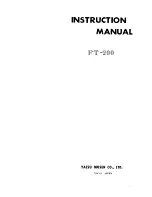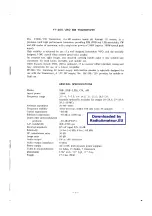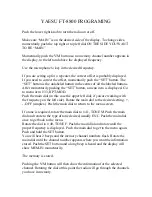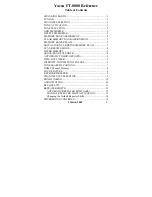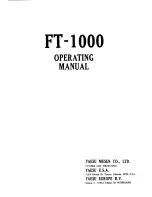
42
USB
AGC
AUTO
SPLIT
RIT
Shown below are the data rates and types of
modulation used for HF Packet operation:
Note
: In some countries, F2 modulation at 1200 bps may be used
on the 10-meter band. Consult your national Amateur radio
organization to obtain band plans that specify where in each band
various modes are used.
PACKET FREQUENCIES
AMTOR activity can be found on or near 14075 and
3637.5 kHz. These would also be good starting places
when searching for PacTOR, G-TOR
TM
, or Clover
stations.
This completes the “DIGITAL OPERATION” section.
Refer to “OPERATING AIDS” beginning on page 44 for
information about additional useful functions for
operating.
6 COMMUNICATING
SPLIT-FREQUENCY OPERATION
Split-frequency operation uses one VFO for the receive
frequency and the other VFO for the transmit frequency.
While operating “split”, the VFOs switch automatically
when you switch from receive to transmit and vice
versa. This allows you to move either VFO frequency
independently without affecting the other.
When a rare or desirable station is heard, he or she
may immediately get many responses, all at the same
time. It quickly becomes difficult to separate and
identify both the original calling station (usually a DX
station), and the many responding stations. This “DX
pileup” is exciting, but it is also very inefficient and
frustrating. Often the DX station is lost under the noise
and confusion of many calling stations.
If things grow out of hand, it is the DX station’s
responsibility to take control by announcing that he will
be “listening up 5 (kHz, from his present transmit
frequency)”, or “listening down between 5 and 10
(kHz)”. This usually means the DX station will not
change his transmit frequency, but will begin split
operation in order to tune among the calling stations,
pick out a call sign or two, and begin working those
stations. Since, for the moment, the DX station is
holding his transmit frequency, you should not change
your receive frequency.
If you find that you are suddenly being called as that
rare or desirable station, your ability to control the
situation and complete contacts is much improved by
“going to split”. The following procedure explains how to
operate split frequency on the TS-870S.
1
Press
[RX A]
or
[RX B]
or
[RX M.CH]
.
•
Your receive frequency will be the current
frequency selected by VFO A, by VFO B, or by
the current memory channel respectively.
•
If you press
[RX M.CH]
, then that memory
channel must contain a split channel unless you
select a VFO for the transmit frequency in the
next step. See “MEMORY CHANNEL
STORAGE, Split-frequency Channels” {page 55}.
2
Press
[TX A]
or
[TX B]
or
[TX M.CH]
.
•
Your transmit frequency will be the current
frequency selected by VFO A, by VFO B, or by
the current memory channel respectively.
•
If you pressed either
[RX A]
or
[RX B]
in Step 1,
then you must select the other VFO in this step,
or press
[TX M.CH].
•
When you recall a split memory channel to select
a transmit frequency, the transmit frequency
stored in that channel will be used.
Mode
USB & LSB
USB & LSB
FM
300 bps
(AFSK)
1200 bps
(PSK)
1200 bps
(AFSK)
F1
F1
F2
Data Rate
Modulation Type
1800~1830
3620~3635
7080~7100
10140~10150
14095~14099.5
18105~18110
21090~21100
—
28120~28189
—
3590~3600
Digital band
Digital band
14089~14099, 14101~14112
Digital band
21100~21120
Digital band
28120~28150, 29200~29300
U.S.A./Canada
Frequency (kHz)
IARU Region 1
(Europe/Africa)
Frequency (kHz)
Содержание TS-870S
Страница 104: ......































